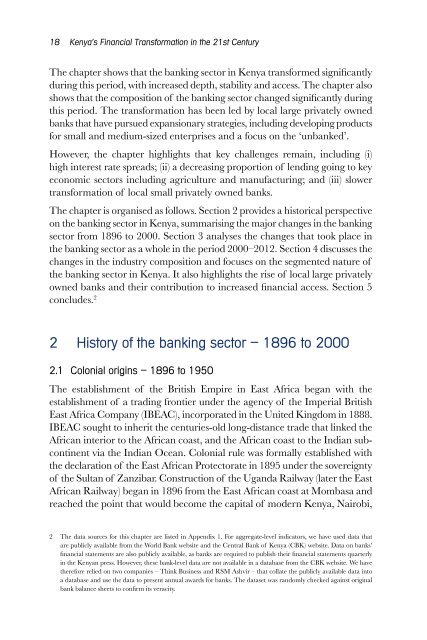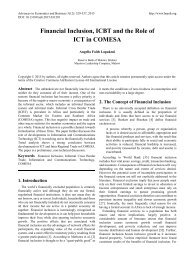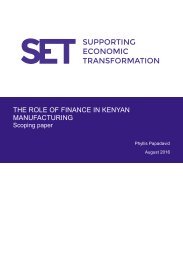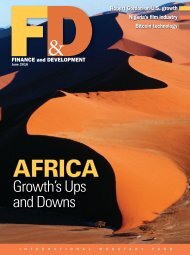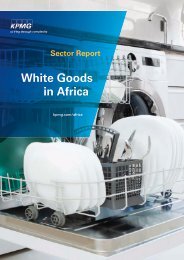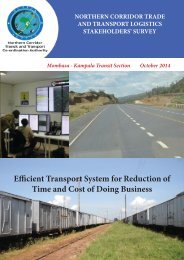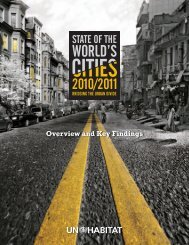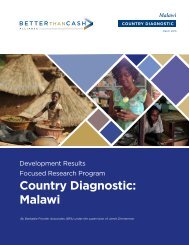in the 21st Century
hTOE305aYVW
hTOE305aYVW
Create successful ePaper yourself
Turn your PDF publications into a flip-book with our unique Google optimized e-Paper software.
18 Kenya’s F<strong>in</strong>ancial Transformation <strong>in</strong> <strong>the</strong> <strong>21st</strong> <strong>Century</strong><br />
The chapter shows that <strong>the</strong> bank<strong>in</strong>g sector <strong>in</strong> Kenya transformed significantly<br />
dur<strong>in</strong>g this period, with <strong>in</strong>creased depth, stability and access. The chapter also<br />
shows that <strong>the</strong> composition of <strong>the</strong> bank<strong>in</strong>g sector changed significantly dur<strong>in</strong>g<br />
this period. The transformation has been led by local large privately owned<br />
banks that have pursued expansionary strategies, <strong>in</strong>clud<strong>in</strong>g develop<strong>in</strong>g products<br />
for small and medium-sized enterprises and a focus on <strong>the</strong> ‘unbanked’.<br />
However, <strong>the</strong> chapter highlights that key challenges rema<strong>in</strong>, <strong>in</strong>clud<strong>in</strong>g (i)<br />
high <strong>in</strong>terest rate spreads; (ii) a decreas<strong>in</strong>g proportion of lend<strong>in</strong>g go<strong>in</strong>g to key<br />
economic sectors <strong>in</strong>clud<strong>in</strong>g agriculture and manufactur<strong>in</strong>g; and (iii) slower<br />
transformation of local small privately owned banks.<br />
The chapter is organised as follows. Section 2 provides a historical perspective<br />
on <strong>the</strong> bank<strong>in</strong>g sector <strong>in</strong> Kenya, summaris<strong>in</strong>g <strong>the</strong> major changes <strong>in</strong> <strong>the</strong> bank<strong>in</strong>g<br />
sector from 1896 to 2000. Section 3 analyses <strong>the</strong> changes that took place <strong>in</strong><br />
<strong>the</strong> bank<strong>in</strong>g sector as a whole <strong>in</strong> <strong>the</strong> period 2000–2012. Section 4 discusses <strong>the</strong><br />
changes <strong>in</strong> <strong>the</strong> <strong>in</strong>dustry composition and focuses on <strong>the</strong> segmented nature of<br />
<strong>the</strong> bank<strong>in</strong>g sector <strong>in</strong> Kenya. It also highlights <strong>the</strong> rise of local large privately<br />
owned banks and <strong>the</strong>ir contribution to <strong>in</strong>creased f<strong>in</strong>ancial access. Section 5<br />
concludes. 2<br />
2 History of <strong>the</strong> bank<strong>in</strong>g sector – 1896 to 2000<br />
2.1 Colonial orig<strong>in</strong>s – 1896 to 1950<br />
The establishment of <strong>the</strong> British Empire <strong>in</strong> East Africa began with <strong>the</strong><br />
establishment of a trad<strong>in</strong>g frontier under <strong>the</strong> agency of <strong>the</strong> Imperial British<br />
East Africa Company (IBEAC), <strong>in</strong>corporated <strong>in</strong> <strong>the</strong> United K<strong>in</strong>gdom <strong>in</strong> 1888.<br />
IBEAC sought to <strong>in</strong>herit <strong>the</strong> centuries-old long-distance trade that l<strong>in</strong>ked <strong>the</strong><br />
African <strong>in</strong>terior to <strong>the</strong> African coast, and <strong>the</strong> African coast to <strong>the</strong> Indian subcont<strong>in</strong>ent<br />
via <strong>the</strong> Indian Ocean. Colonial rule was formally established with<br />
<strong>the</strong> declaration of <strong>the</strong> East African Protectorate <strong>in</strong> 1895 under <strong>the</strong> sovereignty<br />
of <strong>the</strong> Sultan of Zanzibar. Construction of <strong>the</strong> Uganda Railway (later <strong>the</strong> East<br />
African Railway) began <strong>in</strong> 1896 from <strong>the</strong> East African coast at Mombasa and<br />
reached <strong>the</strong> po<strong>in</strong>t that would become <strong>the</strong> capital of modern Kenya, Nairobi,<br />
2 The data sources for this chapter are listed <strong>in</strong> Appendix 1. For aggregate-level <strong>in</strong>dicators, we have used data that<br />
are publicly available from <strong>the</strong> World Bank website and <strong>the</strong> Central Bank of Kenya (CBK) website. Data on banks’<br />
f<strong>in</strong>ancial statements are also publicly available, as banks are required to publish <strong>the</strong>ir f<strong>in</strong>ancial statements quarterly<br />
<strong>in</strong> <strong>the</strong> Kenyan press. However, <strong>the</strong>se bank-level data are not available <strong>in</strong> a database from <strong>the</strong> CBK website. We have<br />
<strong>the</strong>refore relied on two companies – Th<strong>in</strong>k Bus<strong>in</strong>ess and RSM Ashvir – that collate <strong>the</strong> publicly available data <strong>in</strong>to<br />
a database and use <strong>the</strong> data to present annual awards for banks. The dataset was randomly checked aga<strong>in</strong>st orig<strong>in</strong>al<br />
bank balance sheets to confirm its veracity.


